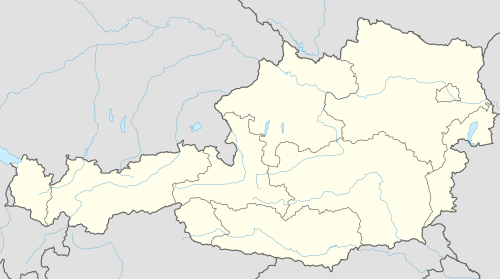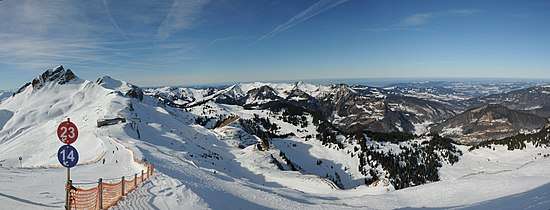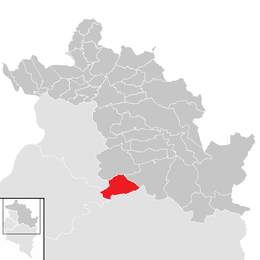Damüls
| Damüls | ||
|---|---|---|
|
| ||
| ||
 Damüls Location within Austria
Location in the district
| ||
| Coordinates: 47°17′N 09°53′E / 47.283°N 9.883°ECoordinates: 47°17′N 09°53′E / 47.283°N 9.883°E | ||
| Country | Austria | |
| State | Vorarlberg | |
| District | Bregenz | |
| Government | ||
| • Mayor | Stefan Bischof | |
| Area | ||
| • Total | 20.92 km2 (8.08 sq mi) | |
| Elevation | 1.428 m (4.685 ft) | |
| Population (1 January 2016)[1] | ||
| • Total | 303 | |
| • Density | 14/km2 (38/sq mi) | |
| Time zone | UTC+1 (CET) | |
| • Summer (DST) | UTC+2 (CEST) | |
| Postal code | 6884 | |
| Website | http://www.damuels.at/ | |
Damüls is a municipality and popular tourism resort in the district of Bregenz in the Austrian state of Vorarlberg. Damüls also holds the world record of the municipality with the most annual snowfall in Europe – the average is 9.30 meters per year. In 2006, Damüls was awarded the honorary title "the snowiest village in the world".[2]
Population
| Historical population | ||
|---|---|---|
| Year | Pop. | ±% |
| 1869 | 383 | — |
| 1880 | 365 | −4.7% |
| 1890 | 278 | −23.8% |
| 1900 | 241 | −13.3% |
| 1910 | 225 | −6.6% |
| 1923 | 204 | −9.3% |
| 1934 | 218 | +6.9% |
| 1939 | 209 | −4.1% |
| 1951 | 223 | +6.7% |
| 1961 | 241 | +8.1% |
| 1971 | 322 | +33.6% |
| 1981 | 304 | −5.6% |
| 1991 | 309 | +1.6% |
| 2001 | 326 | +5.5% |
| 2011 | 316 | −3.1% |
Geography
Damüls has an area of 20.92 km². It lies in the west of the country and borders the Bregenz Forest, the Biosphere Reserve Großes Walsertal, the Laternsertal and all other Vorarlberg districts (Bludenz, Feldkirch and Dornbirn).
The most famous mountain peak in the area, and the purpose of many walks from Damüls, is the Damülser Mittagsspitze (2095 m).
History
Around 1300, Walser fled due to poverty and lack of agricultural land. They were allowed to settle in Vorarlberg, in the west of Tyrol and in Graubünden. From 1313 on, Damüls was populated by Walser. At the time, the Supreme Court (Damüls and Fontanella) was independent - the inhabitants of Damüls, in return, joined the Montfort House in order to serve with "spear and shield" in the event of war.[3]
Culture
The Vorarlberger FIS Skimuseum Damüls offers a journey through the 100-year history of skiing in Vorarlberg. In addition to historic and rare Alpine ski models, ski jump-related objects are also shown.
The church of St. Nikolaus occupies a prominent place in the mountain village of Damüls. The harmonious scenery of this village is largely determined by this striking church.
In the region, many old traditions are still alive and well, and this is expressed in the typical dialect that is still spoken here. Wearing traditional garb ("Tracht") on festive occasions days also contributes to the authentic way of life.
Alpine Transhumance, or mountain meadow culture, is still practiced in Damüls. This means that farmers bring their cattle to places where food is available. Depending on the season, cattle will change stables several times a year. Alpine Transhumance is called "Dreistufenwirtschaft" (literally "three phase economy") in German because the mountain pastures are managed in three stages. It is the basis of the current natural and cultural landscape of this region and the traditional cheese production in Vorarlberg. UNESCO declared the Dreistufenwirtschaft in the Bregenz Forest in 2011 as intangible cultural heritage.

Tourism
Thanks to the merging of the two ski areas of Damüls and Mellau in 2010, the largest ski area in the Bregenz Forest and one of the largest ski regions in the state of Vorarlberg was created: Ski area Damüls-Mellau. The region is known for its abundance of snow.[4]
See also
References
- ↑ Statistik Austria - Bevölkerung zu Jahresbeginn 2002-2016 nach Gemeinden (Gebietsstand 1.1.2016) for Damüls.
- ↑ "Archived copy". Archived from the original on 2013-11-04. Retrieved 2013-11-08.
- ↑ "Das Dorf Damüls | Die Dörfer | REGION". damuels.travel. Retrieved 2018-08-16.
- ↑ "Skiresort Damuels Mellau Faschina | Snowiest village in the world". damuels.travel. Retrieved 2018-08-16.
| Wikimedia Commons has media related to Damüls. |

